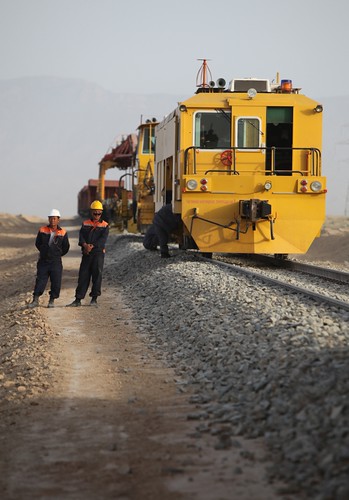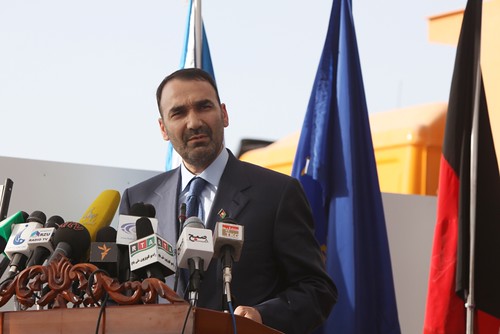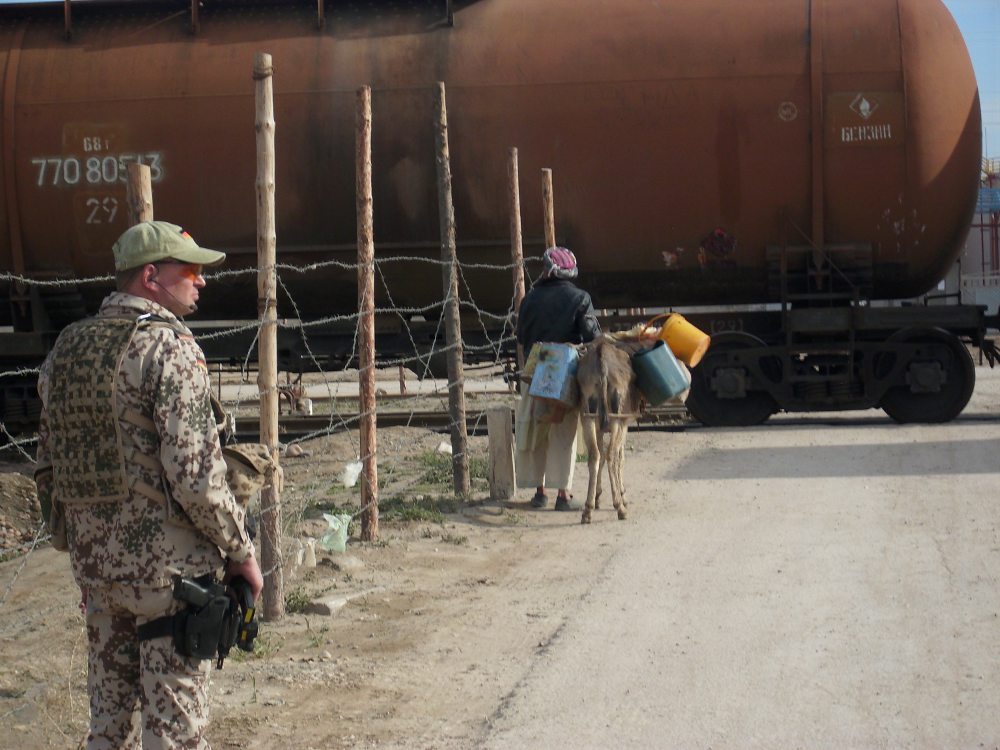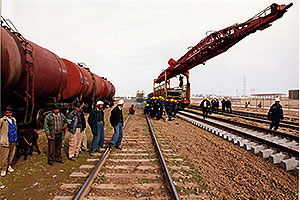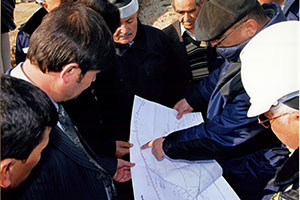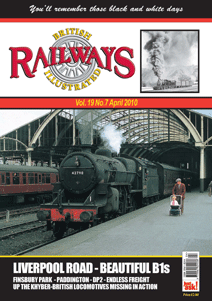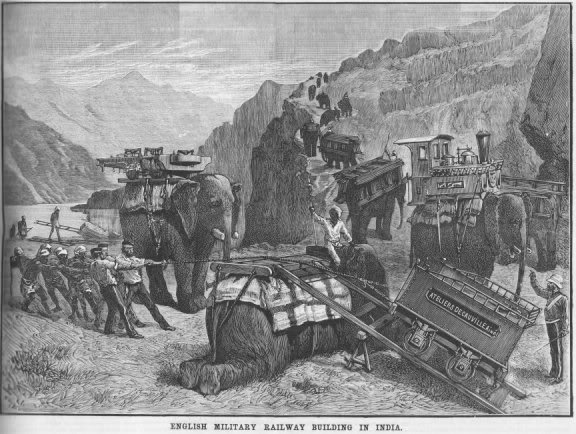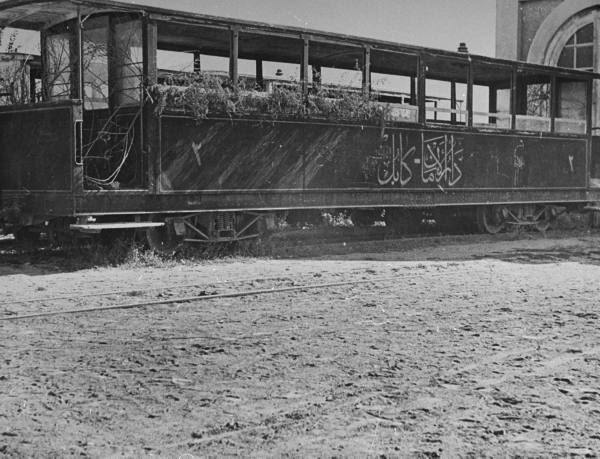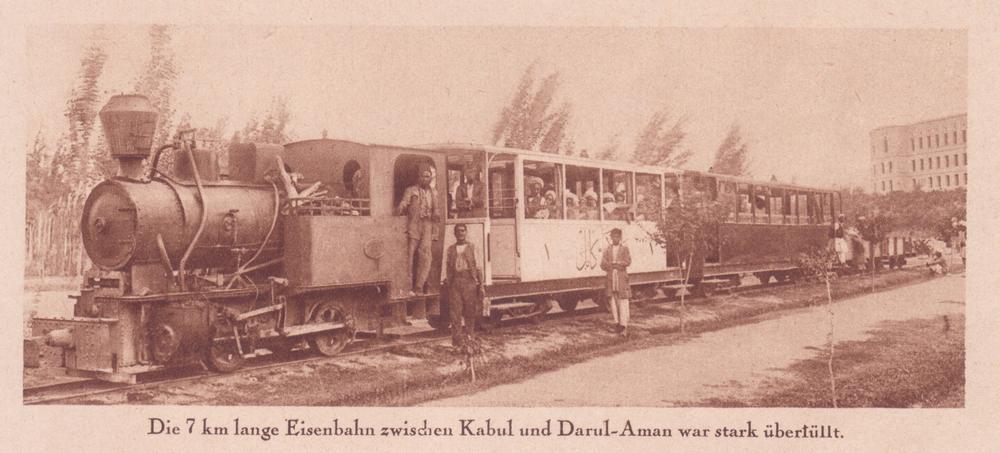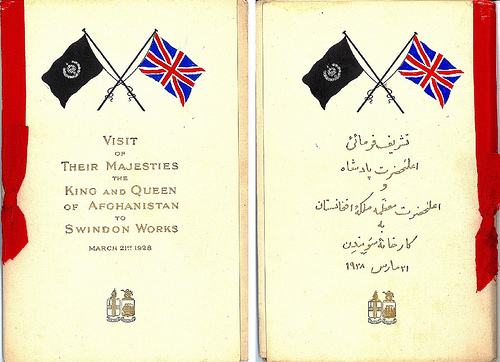Photographs from the American Embassy in Kabul, which has a Flickr site with lots more pictures of the Hairatan Rail Line Ribbon Cutting Ceremony on May 25.
Photographs
Photos of Mazar-i-Sharif railway under construction
At last – photographs proving the railway is really happening!
They are from Isafmedia, and were taken on May 25 when Asian Development Bank President Haruhiko Kuroda visited the construction works.
Railway line from Hairatan Mazar-e-Sharif Hits final stage
The new railway line from Termez to Mazar-e-Sharif will be 75 kilometres long.
The Governor of Balkh Province, Atta Mohammed Noor, during his speech.
The Khojak rope inclines
There is an article about the Khojak Rope Inclines at the Funimag website, which covers funicular railways.
The Khojak tunnel is (now) in Pakistan, on the railway from Quetta to Chaman on the Afghan border.
The defense and the supply of Chaman could not wait for these three years of digging Khojak tunnel. The Indian government decided to build a temporary line of communication, quick and inexpensive to cross the mountains until the end of the work in the Khojak tunnel (1889-1891).
The temporary railway line was built in 1888 and crossed the summit chain Khwaja Amran mountains with the help of four inclined cable railways which allowed to move locomotives and carriages from one side to the other side of the mountain.
[more…]
Hayratan freight terminal pictures
The Army Strong Stories website has an article Hairaton, Afghanistan – On the Uzbekistan Border by Maj. Christopher Lecron. “Containers are off-loaded at the rail yard and put on trucks. We are hoping to expand the rail line further south to reduce costs and increase efficiency.” He also has a March 24 2010 photo of the border.
Hairaton, Afghanistan Hopes to Move More U.S. Military Cargo
Story by Maj. Christopher Lecron
Date: 03.24.2010
Posted: 03.27.2010 01:40HAIRATAN, Afghanistan — The mayor of Hairaton, Afghanistan and several other town logistics officials met with U.S. Air Force Major General Robert McMahon and his staff to discuss potential improvements in the cargo supply chain from Uzbekistan into Afghanistan.
Hairaton is the border crossing for a high volume of truck, rail and river barge cargo transiting into Afghanistan.
“We are always looking for additional supply routes into Afghanistan and we hope to improve the route through Hairaton with a rail line that extends all the way to Masar-e Sharif,” said McMahon. Currently, the rail line ends at Hayraton and containers are trans-loaded onto trucks for onward movement.
McMahon is the director of the Central Command Deployment and Distribution Operations Center. The agency monitors and optimizes the flow of cargo into Afghanistan. After reading daily reports of U.S. forces cargo transiting Hairaton, the team wanted to survey the town and logistics center with their own eyes. The trip included a walking tour of the rail yard, truck border crossing, and river barge site. German soldiers from nearby Camp Marmal provided a security detail for the trip.
Hikmat Rahmetov, a representative from Hapag-Lloyd, served as the subject matter expert for Hairaton logistics. Rahmetov routinely works with U.S. military agencies to transport containers by truck and rail from Hayraton into Afghanistan. Hapag-Lloyd mostly moves U.S. military cargo through Hayraton, but hopes to expand shipping to include NATO cargo as well.
With very safe, secure areas, welcoming government and commercial partners, Hayraton is an ideal place to increase the flow of re-supply into Afghanistan. The potential completion of a rail line that runs south from Hairaton would only increase the volume and efficiency of cargo flow. In addition, increased transportation requirements would create more jobs and help to fuel the local economy.
Source: DVIDS, 2010-03-24
ADB article about the Hayratan railway project
An article from the Asian Development Bank’s Media Center about the Hayratan to Mazar-i-Sharif project – with the first photographs I’ve seen of railway construction work underway.
The ADB also has an article about railway modernisation in Uzbekistan.
Railway to Regional Integration
by Philip Wood
Today, as new trade routes connect landlocked Central Asia with the booming economies of South Asia and the Middle East, Afghanistan’s geographic position is proving a valuable asset.
Hairatan, Afghanistan—For centuries, Afghanistan’s strategic location has been a liability, inviting unwanted attention from countries near and far. But today, as new trade routes connect landlocked Central Asia with the booming economies of South Asia and the Middle East, Afghanistan’s geographic position is proving a valuable asset.
The bulldozers on the dusty northern plains of Hairatan attest to the fact that Afghanistan is poised to become a regional hub for trade and commerce. It is here, across the river from neighboring Uzbekistan, that the building blocks of a 75-kilometer single-line railway are being laid—thanks to a $165 million ADB grant.
The Hairatan border post is the gateway for almost half of Afghanistan’s road imports, but the existing transport infrastructure cannot cope with expanding trade and humanitarian relief. When completed in late 2010, the new rail line will remove the major bottlenecks that have formed at the border, quadrupling capacity and boosting regional trade.
As part of the Transport Strategy and Action Plan under the Central Asia Regional Economic Cooperation Program (CAREC), the project will open alternative routes of supply for national and international trade, as well as for humanitarian relief coming into Afghanistan.
The new line will connect Afghanistan to Uzbekistan’s expansive rail network. The initial segment will run between Hairatan and Mazare-e-Sharif, Afghanistan’s second largest city. Future links are planned that will run across the north to other parts of the country and region, including Herat, Pakistan, Tajikistan, and Turkmenistan.
“The new train line will boost freight volumes, lower costs, and raise the profile of Afghanistan as a transit route,” said ADB Afghanistan Country Director Craig Steffensen. “In addition, Central Asian states and Xinjiang, People’s Republic of China, will be able to access world markets more cheaply and easily via Afghanistan and seaports on the Gulf, thus improving their competitiveness in world markets.”
Founded in 1997, CAREC is a partnership of eight countries: Afghanistan, Azerbaijan, the People’s Republic of China, Kazakhstan, the Kyrgyz Republic, Mongolia, Tajikistan, and Uzbekistan; and six multilateral institutions: ADB, the European Bank for Reconstruction and Development, the International Monetary Fund, the Islamic Development Bank, the United Nations Development Programme, and the World Bank.
At the heart of CAREC is a plan to develop a seamless network of transport corridors connecting member countries to one another, to fast-growing economies of East and South Asia, and to established markets in Europe and the Russian Federation.
Source: Asian Development Bank, 2010-03-30
Wheat by rail in Afghanistan
There is a small photo from 2007 on the website of the Private Sector Development Directorate of Afghanistan’s Ministry Of Commerce And Industry, which shows the off-loading of wheat imported from Uzbekistan at Hayratan.
The caption says The rail-wagons carry the wheat from Uzbekistan, off-load, and return empty. In the absence of facilities in Hairaton, these wagons could be utilized to export/transit goods from Afghanistan to Uzbekistan and beyond. However, there is no formal arrangement between the two countries to allow such exports or transit of goods through Uzbekistan.
Pakistan Railways steam photos
The April 2010 issue of British Railways Illustrated magazine has an article with lots of photographs of the Khyber Pass line taken by Gavin Morrison in the 1970s. There is a companion article about Pakistani narrow gauge in the April 2010 Railway Bylines, with basically the same text but different pictures.
The text isn’t especially detailed, being a brief description of the visit, rather than a history of the lines, but there are some very nice pictures of steam engines in action in spectacular scenery.
Sadly the Khyber Pass line is now out of action, with sections having been washed away and revival seemingly a distant prospect – unless the Chinese decide to rebuild and extend it to serve their Afghan copper mining concession at Aynak.
The 2’6″ gauge railway from Bostan to Zhob (Fort Sandeman) has closed. The track was lifted by the authorities to prevent (further) theft, although the government has announced plans to rebuild it as a 1676 mm gauge line and construct a 150 km extension to Dera Ismail Khan, cutting 400 km from the distance by rail between Quetta and Peshawar.
Elephants carrying locomotives through the Bolan Pass
Posted by Robert Grauman at Practical Machinist is an article about railway construction during the Great Game which appeared in 15 August 1885, issue of Scientific American, having originally appeared in French magazine L’Ilustration. I guess it is now out of copyright, so I’ll post it here too.
The Bolan pass is now in Pakistan.
An English military railway
“The English army has succeeded in establishing a portable railway on several points of the Bolan Pass. This railroad is of the Decauville system, formed in sections of small steel rails, which can be put down or taken up very quickly. This ingenious railway – which has been used considerably for work on the Panama Canal and for the transportation of sugar cane in Australia and Java – has become the indispensable means of transport in all wars. It is at present being used in Tonquin and Madagascar by the French army, and is also being used on the Red Sea by the Italian army. When the Russian government commenced the war in Turkestan, in 1882, it bought one hundred versts, or about 66 miles, of the Decauville railroad, which Gen. Skobeleff used with great success for the transportation of potable water and for all the provisions for his army. This railroad was taken up as the army marched forward, and when the Russians advanced recently, in Afghanistan, the little railway appeared at the advance posts, and was described to the English army by the officers who watched the operations for the Afghans. An order for a similar apparatus was given by the English government to M. Decauville, directions being given that the road should be of the same type as that furnished to the Russians. The object of this was, probably, that any sections of road which might be captured from the Russians during the war could be used by the English. In this last order there was one problem which was very difficult to solve; all the material had to be carried by elephants, and they wanted a locomotive. M. Decauville had the locomotive made in two parts, the larger of which weighed on 3,978 pounds, the greatest weight that an elephant can carry.”“This episode of the Anglo-Russian conflict, illustrated in the annexed cut, is a great conquest for our national industry, for the works of M. Decauville are at Petit-Bourg, that is, in France, and only an hour from Paris. They cover about 20 acres on the bank of the Seine, and adjoin the P.L.M. The great hall is 525 feet long by 525 feet deep. The material is brought in at both ends (at one end the rails and steel for the road, and at the other end the sheet metal and iron for the cars), and the manufactured products are taken out at the middle, loaded in the cars of the P.L.M Co. In July, 1884, the works of Petit-Bourg attained their greatest development, with a thousand workmen, and 350 machines, which do the work of 3,000 men. Among others, there are four painting machines, which do the work of 60 painters. Three thousand cars and 93 miles of road are produced each month.”
Source: Scientific American, 15 August 1885, quoted at Practical Machinist‘s Antique Machinery and History forum 2010-02-26
Kabul railway coach photo
Google’s archive of photos from Life has this one (above) captioned “Deserted Afghan railway car after failure to begin rail system”.
Dated 1938 in the caption, the picture shows an overgrown bogie coach from the short-lived narrow gauge railway which ran for 7 km between Kabul and Darulaman.
The number painted at each end is “2” – a vehicle number, or a class number? The coach is noticeably longer than one in labeled “1” in this picture below, which was taken by Wilhelm Rieck in 1923 and is said to show the first train, so perhaps it is a class number, with the bigger coach being second class.
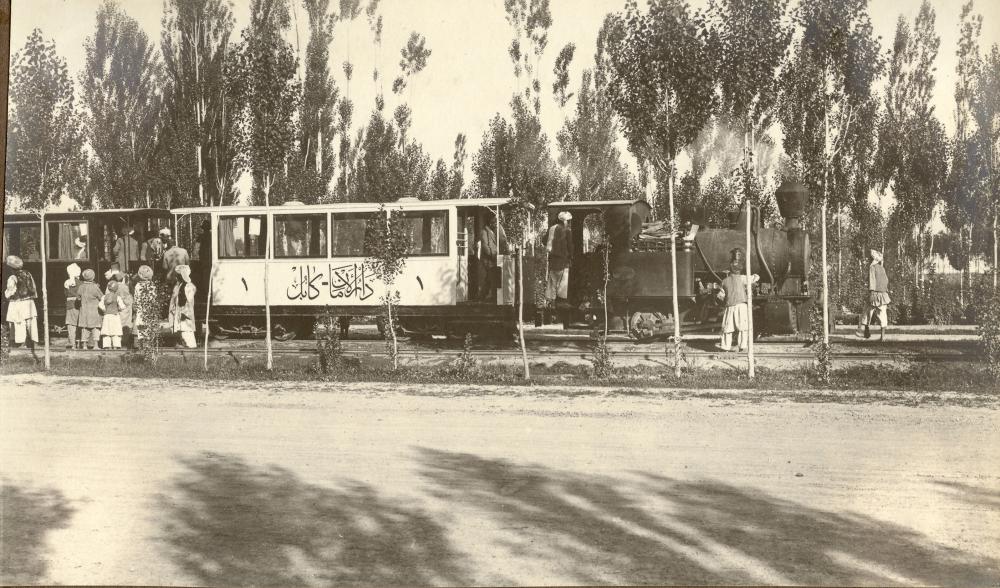
The Life photo shows another coach at the back, apparently a lighter colour, which is presumably the first class car. But is there a third vehicle as well, in front of that one?
This picture below appeared in the February 1930 issue of the German magazine UHU, and shows two coaches plus some wagons.
Amazingly, the locomotives have survived, though only the underframes of the coaches remain.
Visit of their Majesties the King and Queen of Afghanistan to Swindon Works
Swindon Local Studies Collection has an image of the commemorative booklet containing an illustrated history of Swindon works in Persian which was produced when King Amanullah visited the Great Western Railway‘s works on 21 March 1928.
The Queen did not attend as had been planned: “it was understood that the Royal lady was too fatigued to bear the journey” reported Railway Gazette on 23 March 1928.
The booklet included portraits of the GWR’s Chairman, Deputy Chairman, General Manager and Chief Mechanical Engineer.
British Pathe has some old film KING AMANULLAH IN SWINDON:
Royalty. Amir of Afghanistan Amanullah Khan visits England. The Amir and his entourage visit a railroad engine factory. Dark but interesting footage. The group watches a worker using a gun to spray paint or some sealant on a railroad freight car; the man wears a mask to protect himself from chemicals. The men walk by a locomotive rotating on a turntable outside factory. Interior: they walk through large space w/ many sets of train wheels lined up. Heavy machinery moving another set of wheels overhead. Next; they gather around a finished locomotive. Exterior again;the group walking along beside train. Entering train coach. This visit is probably from 1921 [sic]; when A.K. signed a treaty w/ Great Britain.
I suspect 1921 should say 1928, making it the same as the visit above and as listed by the British Film Institute.
There is also a photo The King of Afghanistan visits the Swindon railway works, Wiltshire, 1928 at the Science & Society Picture Library.



